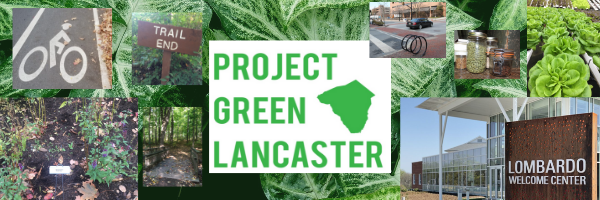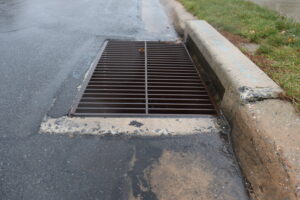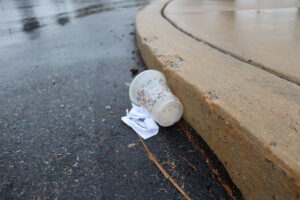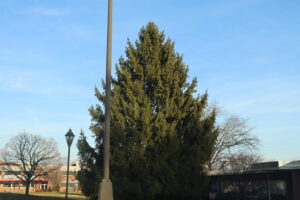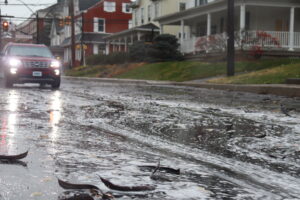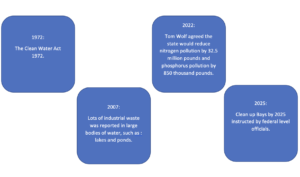Surrounding Rivers Contaminate Chesapeake Bay
Effects of runoff pollution compromise residents near Chesapeake in surrounding areas like Pennsylvania are affected by stormwater runoff pollution.
by Thomas Cannon
What is stormwater runoff pollution?
In Lancaster County, two historically grounded bodies of water flow into the Chesapeake Bay, those two bodies of water being the Conestoga River and Susquehanna River. As runoff pollution rises, the Chesapeake Bay and the surrounding
rivers that are connected to it are directly affected. This type of runoff is one of the most harmful types of pollutants to these waterways. The places where this type of pollution occurs are urban and suburban areas. Unlike suburban and urban areas, more rural areas aren’t as compromised because of the population of motor vehicles. Those Rural areas also have man-made systems. in the More populated areas, there is ground that can only absorb so much water from the rain before there is an excess amount which causes stormwater runoff.
What Causes This Type of Pollution?
There are many causes of runoff pollution such as trash, soil and sediment, fecal bacteria road salt and nitrogen and phosphorus etc. This type of pollution can affect the quality of water because it contaminates it with bacteria. If the quantity of the water is affected by the runoff pollution, it can cause the treatment of the water to be more expensive. Not only does it affect the water quality, but it also in dangers aquatic life within these bodies of water and reshapes the watershed depths. Fish and aquatic life are being put at risk for this pollution and potentially contaminate the water as more and more aquatic animals die. After researchers did a survey according to Polluted Stormwater Runoff a Growing Threat, Floyd states, “Researchers have detected pesticides (including sometimes dieldrin and the now-banned chlordane) in 97 percent of suburban and urban runoff samples nationally, and at levels high enough to harm aquatic life 83 percent of the time” (Floyd). This staggeringly high number represents how high the potential rate of death is for aquatic life with having runoff pollution. With currents at a stronger level, banks can shift and can change the depth of the banks. This can also affect the residents of these different counties in Lancaster, with certain areas being compromised for flooding if there is not a proper drainage system. There are potential problems that could arise if there is no action taken to stop runoff pollution.
How Can We Help?
One of the big solutions to runoff pollution is forms of planting. Things like planting trees, planting gardens on rooftops, and also planting rain gardens in areas where there are key spots for drainage. Alongside planting, replacing the old pavement with previous payment is ideal for helping to alleviate this type of pollution. These kinds of solutions are cost-effective as well and can also provide benefits to these communities with shade and habitats for wildlife.
The Chesapeake Bay Foundation calls these solutions to mouth pollution a “green filter”. Especially on the roads, there are many toxins that are released and can be washed away into the drains on the roadways, causing them to contaminate that water. According to Polluted Stormwater Runoff a Growing Threat, Floyd states, “In Maryland alone, the population grew by 39 percent, but the developed land multiplied by 154 percent from the 1970s through the early 2000s” (Floyd). This spike in population could be a potential reason why the Chesapeake is in the condition that it is right now.
As runoff pollution in creation increases the more, it can affect the communities and residents around these areas. The solutions to these problems can be cost-effective and beneficial to helping solve this problem. There are many ways people can help on a smaller scale by planting and using resources that are available. Green filters are the future to stopping stormwater runoff pollution.
Meet Inger Andersen
Inger Andersen is the Under-Secretary-General of the United Nations and Executive Director of the UN Environment Programme. In a speech delivered by Inger Andersen, she talks about pollution and how we need to put an end to it. While also mentioning that these forms of pollution are a violation of our human right to have a clean environment. And a 2021 progress report from the Ellen MacArthur Foundation that Inger talks about the approach that they are taking, which is baby steps that will form into adult strides eventually, but there is a progression which is good. To finish off his speech, she said, “We have a zero-pollution ambition. Every government, every business, every investor, every organization, and every individual has a responsibility to act to achieve it”.
‘
Meet the EEC
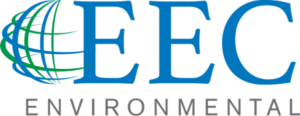
EEC Logo from eecenvironmental.com
The EEC (expert environmental consulting services) is a foundation that helps consult people with their services. For over 20 years, this foundation has been focusing on helping the decline of stormwater runoff pollution. The EEC says that they are willing to help people that want to stop this type of pollution with plans, practices, and other tools in order to put a stop to this issue. They also have programs in plans that work with industrial, commercial, and municipal industries to have the most efficient plan to disperse rainwater. These plans that the EEC set in place comply with federal, state, and local laws.
Federal Cleanup Plan
In Pennsylvania, there has been a plan set in place due to federal instruction to clean the bay waters up. The date that is set in place as of right now to have this done by is 2025. This is not the first attempt to clean up these waterways, it will be the third attempt. In an attempt to stop this pollution and to clean up these waterways to be cleaner the plan will be allocated $300 million dollars to work with during the project. In addition to this plan, some faculties and organizations like the U.S. Department of Defense and the National Park Service, to name a couple, will be reducing the amount of phosphorus admissions to reduce pollution.
Chesapeake Bay Safety and Environmental Hotline
Taking action in small ways will help stop stormwater runoff pollution. There are many ways to report environmental issues 24/7. The Chesapeake Bay Safety and Environmental Hotline phone number is 1-877-224-7229. This hotline will take you to the correct department to handle the environmental issue. There are also ways of funding to help runoff pollution, such as the Anne Arundel County Property Tax Credit. This allows property owners that are eligible in Anne Arundel to receive tax credit that helps fund stormwater runoff pollution. In these efforts to put a stop order to reduce the amount of pollution, it will save the lives of residents and animals within the community.
Pollution Cleanup Throughout The Years Timeline
References
Cano, S., Supervisor, S. M., District, C. M. S., Wager, J., Manager, C., Stanton, Burk, R., Engineer, P. C., & Ana, C. of S. (n.d.). Home – expert environmental consulting. Expert Environmental Consulting -. Retrieved December 3, 2022, from https://eecenvironmental.com/
Chesapeake Bay Action Plan. After decades of effort, the voluntary, collaborative approach to restoring the health and vitality of the Chesapeake Bay- the largest estuary in the United States-has not worked and, in fact, is failing. A diverse group of 57 senior scientists and policymakers have joined forces to save the Bay. This is our plan. (n.d.). Retrieved December 3, 2022, from https://bayactionplan.com/stormwater-management/
Delagarza, A. (2022, July 25). What to know about pa.. DEP’s newest plan to reduce pollution to the Chesapeake Bay | stateimpact Pennsylvania. NPR. Retrieved December 3, 2022, from https://stateimpact.npr.org/pennsylvania/2022/07/26/what-to-know-about-pa-deps-newest-plan-to-reduce-pollution-to-the-chesapeake-bay/%C2%A0
Floyd, D. (n.d.). Polluted stormwater runoff: A growing threat. Chesapeake Bay Foundation. Retrieved November 22, 2022, from https://www.cbf.org/issues/polluted-runoff/polluted-stormwater-runoff-a-growing-threat.html
History.com Editors. (2009, November 6). Water and air pollution. History.com. Retrieved December 5, 2022, from https://www.history.com/topics/natural-disasters-and-environment/water-and-air-pollution
NASA. (2020, August 13). Cutting harmful runoff into the Chesapeake Bay. NASA. Retrieved November 22, 2022, from https://appliedsciences.nasa.gov/our-impact/story/cutting-harmful-runoff-chesapeake-bay
Schlyer, K. (n.d.). Runoff Pollution. Chesapeake Bay Foundation. Retrieved November 22, 2022, from https://www.cbf.org/issues/polluted-runoff/index.html
United Nations Environment Programme. (n.d.). End pollution. secure the right to a healthy environment. UNEP. Retrieved December 3, 2022, from https://www.unep.org/news-and-stories/speech/end-pollution-secure-right-healthy-environment
United Nations Environment Programme. (n.d.). Inger Andersen. UNEP. Retrieved December 3, 2022, from https://www.unep.org/people/inger-andersen
What is stormwater management and why is it important? – expert environmental consulting. Expert Environmental Consulting -. (2018, January 31). Retrieved December 3, 2022, from https://eecenvironmental.com/what-is-stormwater-management/%C2%A0
